-
Sous Vide Time and Temperatures
Sous Vide Time and Temps
Sous Vide Time and Temps
Sous Vide Temps
- All Sous Vide Temperatures
- Sous Vide Beef Temperatures
- Sous Vide Chicken Temperatures
- Sous Vide Duck Temperatures
- Sous Vide Fish Temperatures
- Sous Vide Vegetables Temperatures
- Sous Vide Infusions Temperatures
- Sous Vide Lamb Temperatures
- Sous Vide Pork Temperatures
- Sous Vide Shellfish Temperatures
- Sous Vide Turkey Temperatures
- Recipes Recipes Recipes Recipes
- Getting Started Guides Getting Started Guides Getting Started
- Equipment and Tools Equipment and Tools Equipment Equipment and Tools
- More Resources More Resources Resources More Resources
How to Use Agar Agar in Cooking
More Modernist Ingredients
•
Agar Agar • Gelling
Click here to get great sous vide content via email
This post may contain affiliate links. Read more.
Written by Jason Logsdon

This isn't just your mother's Jell-o. Modernist gelling ranges from tender panna cotta and custards to fluffy marshmallows and gel cubes.
Agar, or agar agar, is an extract from red algae that is often used to stabilize emulsions or foams and to thicken or gel liquids. While many people in America have only heard of it lately, it has been used for hundreds of years in Asian cooking. Agar is also relatively straightforward to work with and easy to find online, making it a great place to start experimenting with modernist cooking.
Table of Contents

- What is Agar Used For?
- Where to Buy Agar?
- What is Agar?
- How Do You Add Agar To a Liquid?
- How Much Agar to Use?
- How to Create an Agar Gel
- How to Make an Agar Gel Cube
- How to Make Tender Agar Gels
- How to Create an Agar Fluid Gel
- How to Make an Agar Noodle
- How to Make an Agar Foam
- How to Make an Agar Pearl
- How to Make an Agar Gel Coating
- How to Make Gel Sheets
What is Agar Used For?Top
Agar is an amazing culinary ingredient. It's a thickening agent for soups, fruits preserves, ice cream, sauces, jelly-based desserts, custards, puddings and other tasty treats. Agar easily gels most liquids and the gels can range from soft to hard, depending on the amount used. It is also great at making dense foams, especially when used in conjunction with the whipping siphon. If an agar gel is blended, it creates a thick fluid gel that is perfect for sauces.
Agar is suitable for vegans, vegetarians and is suitable for most religious diets. It is also used as a clarifying agent in brewing.
One common non-culinary use of agar is for scientific purposes in the labs to provide a growth medium for organisms in a petri dish. In small quantities, this natural ingredient is incorporated into modeling clay for young children to play with. It is also used as an impression material in dentistry. Due to agar's high fiber content it can also be found in laxatives and appetite suppressants.
Where to Buy Agar?Top
You can buy agar several places. We highly recommend ModernistPantry.com, they have great service and are really good to work with (because of this, we do have an affiliate relationship with them). In addition to online, It can generally be found in Asian supermarkets and health food stores as flakes or powder.
What is Agar?Top
Natural agar is an extract from red algae and is white and semi-translucent with no discernible flavor. It produces a firm clear jelly and is rich in iodine and trace minerals.
The unusual and complex carbohydrates that form agar are a component of the cell walls of several species of red algae that are usually harvested in the Red Sea, eastern Asia and California, to name a few. Agar consists of approximately 80% fiber.

Agar is also known as Agar Agar, Agazoon Agar, Kanten (its Japanese name), China grass (in Indian cuisine). Agar is available in different forms: bars, flaked and powdered, and in the UK you are most likely to find it in the flaked or powdered forms.
The gelling ability of agar is affected by the acidity or alkalinity of the ingredients it is mixed with. More acidic foods, such as citrus fruits, kiwi and strawberries, may require higher amounts of agar. Some ingredients will not set with agar at all unless the enzymes in those fruits are first broken down by cooking. These would include fresh pineapple, figs, paw paws, papaya, mango and peaches. In addition, chocolate and spinach just seem to prevent agar from setting.
How Do You Add Agar To a Liquid?Top
In order for agar to be used effectively it has to be correctly dispersed and hydrated.
Agar Dispersion
Agar can be dispersed easily in hot or cold liquids. Using an immersion blender or standing blender is very effective but normally even a whisk will work fine.
Agar Hydration
In order for agar to work successfully it first needs to hydrate, or absorb water. To properly hydrate agar it must be brought to a boil at 212°F (100°C) and simmered for 3 to 5 minutes.
Agar does not hydrate well in acidic liquids, making gelling difficult. To get around this issue, first hydrate the agar in a neutral liquid and then add it to the acidic liquid.

Sometimes you do not want to bring the liquid you are gelling to a boil. In this situation you have two options to hydrate the agar. First, you can disperse and hydrate the agar in a small amount of the liquid and blend the rest of the liquid into it after hydration. Second, you can disperse and hydrate the agar in water, then blend the liquid into that.
With either method the temperature will drop quickly and the gel will start to set as soon as it gets below 113°F (45°C). Therefore it is advisable to warm up the liquid as much as you can in order to get the best dispersion once the agar has hydrated.
How Much Agar to Use?Top

The amount of agar used will depend on the technique you are using it for.
Agar Gel Ratio
The firmness of an agar gel is determined by the amount of agar used to create the gel. The more agar that is used, the firmer the gel will be. Typically 0.2% agar is used for soft gels increasing up to 3.0% for firmer gels.
Agar Fluid Gel Ratio
Fluid gels are usually made out of gels with a 0.5% to 2.0% ratio; the more agar used in the original gel results in a thicker fluid gel.
Agar Foam Ratio
Agar foams use 0.3% to 1.0% for light foams and 1.0% to 2.0% for denser foams.
Check out how to measure modernist ingredients for more information on ratios.
How to Create an Agar GelTop
Creating a gel with agar results in a brittle gel. However, the firmness of the gel will depend on how much agar is used. Agar gels will usually range from 0.2% agar in a very soft gel to 3.0% agar in very firm gels.
To make a chewier, more elastic gel you can replace from 5% to 15% of the agar with locust bean gum. If you are using gelatin, it should be incorporated when the agar is added and at about the same weight as the agar.

Making an agar gel takes just a few steps. First disperse the agar in the flavored liquid you want to gel using a whisk or blender. Then bring the liquid to a boil for 3 to 5 minutes. Pour the liquid into molds and let it set at room temperature. The gel will actually set at 104°F to 113°F (40°C to 45°C) and remain a gel as long as it stays below 175°F (80°C).
Once it has set, the gel can be turned out, shaped, and plated. The gel will also last for a day or two, though it starts to lose some of its texture and moisture as it dries out over time through syneresis, the leaking of liquid from a gel. You can usually rehydrate the gels by placing them in water.
A nice property of agar gels is that they can be used hot or cold. They will not melt until they go above 176°F (80°C) which allows you to use them in soups or other hot foods. Please be careful serving gels that are at such a high temperature since they can cause severe burns because many people expect them to be cool.
They can also be melted and re-set multiple times without a loss in strength. However, you cannot freeze agar gels, since freezing causes a loss in liquid and texture, unless you are trying to clarify liquids through the freeze thaw technique.
Examples of Agar Gel
 Agar Bloody Mary Gel Recipe
Agar Bloody Mary Gel Recipe  Roasted Poblano, Corn and Bacon Bite Recipe
Roasted Poblano, Corn and Bacon Bite Recipe  Strawberry Daiquiri Agar Gel Cubes Recipe
Strawberry Daiquiri Agar Gel Cubes Recipe
How to Make an Agar Gel CubeTop
Using agar is a great way to create a wide variety of gels. The amount of agar used ranges from 0.2% for soft gels increasing up to 3.0% for firmer gels. The addition of locust bean gum increases the elasticity of agar gels, making them hold together much better. For a good starting spot when making cubes, I usually use a 0.9% agar and 0.1% locust bean ratio.
Gel cubes can be made out of most liquids though I find cocktails, broths, or juices tend to work best.
One of the more interesting properties of agar gels is that once they are set, they can be reheated without melting. You can use this to make hot gel cubes of any of the infused broths, or any hot cocktails.

You can either set the gel in silicon molds, or just use a rectangular container and then cut it into cubes once it has set. When the gel is setting, you can also add garnishes to it, creating whimsical taste sensations.
If you are making alcoholic gels, I recommend first combining the agar with any juices or mixers then boiling it before whisking the alcohol in at the end. This helps prevent any evaporation of the alcohol. The cubes can be made ahead of time but be sure to refrigerate them if you aren't serving them for a few hours.
Ingredients for Agar Gel Cubes
- 400g liquid
- 3.6g agar, 0.9%
- 0.4g locust bean gum, 0.1% (optional)
Instructions for Agar Gel Cubes
Combine all the ingredients in a pot and blend well to combine. Bring to a boil while stirring occasionally. Let simmer for 3 to 5 minutes, stirring regularly.
Pour the agar mixture into a mold or a rectangular container and let it completely set. Once set, cube the gel.
Examples of Agar Gel Cubes
 Strawberry Daiquiri Agar Gel Cubes Recipe
Strawberry Daiquiri Agar Gel Cubes Recipe  Apple Cider Agar Gel Cubes Recipe
Apple Cider Agar Gel Cubes Recipe  Papaya Agar Agar Gel Cube Recipe
Papaya Agar Agar Gel Cube Recipe
How to Create an Agar Fluid GelTop

Fluid gels are substances that behave like a gel when at rest and like a liquid when force is applied. Ketchup is probably the best know example of a fluid gel, as anyone that has struggled to get it out of the bottle, only to have it flood their hamburger, can attest. Other common examples are puddings and custards.
Once you understand how agar gels work, it is very easy to create fluid agar gels. The simplest way to create an agar fluid gel is to create a normal agar gel then puree it until smooth using an immersion blender or standing blender. It is ready to use as is or you can thicken the fluid gel by adding some xanthan gum or thin it out by adding water or another liquid.
To create the gels used for fluid gels a ratio of 0.5% to 2.0% will result in a fluid gel ranging from runny to pudding-like.
Examples of Agar Fluid Gel
 Carrot Planks with Pea Pudding Recipe
Carrot Planks with Pea Pudding Recipe  Halibut with Citrus Pudding Recipe
Halibut with Citrus Pudding Recipe  Pork with Roasted Apple Pudding Recipe
Pork with Roasted Apple Pudding Recipe
How to Make an Agar NoodleTop
Most gel noodles are made with agar. It is mixed into a liquid and hydrated, then pushed into tubing to cool. Once it's cool, it is removed from the tubing and can be used as noodles or garnish. A 1% ratio of agar usually works very well but for a stronger noodle I will use 0.9% agar and 0.1% locust bean gum.
Examples of an Agar Noodle
View more agar noodle recipes, learn more about gels and gelling techniques, or how to measure modernist ingredients for more information on ratios.How to Make an Agar FoamTop

Agar foams are made from agar fluid gels that are dispensed from a whipping siphon. These foams are thick, fine foams that are very dense. Because agar holds its shape under higher temperatures these foams can be served hot or cold.
For agar foams, the more agar you use the denser the resulting foam will be. For light foams, a ratio of 0.3% to 1% works well. For denser foams 1% to 2% is recommended. You can also add gelatin, locust bean gum, or xanthan gum to change the density of the foam.
Examples of Agar Foam
View more agar foam recipes, learn more about modernist foams, or how to measure modernist ingredients for more information on ratios.How to Make an Agar PearlTop
Gel pearls are made by adding agar to a liquid and hydrating it. The liquid is then dripped into a glass of very cold oil. As the liquid sinks it forms into a sphere which then gels.
Examples of Agar Pearls
View more agar pearl recipes, learn more about gels and gelling techniques, or how to measure modernist ingredients for more information on ratios.How to Make an Agar Gel CoatingTop
You can get creative when applying the coating in order to fashion different end results. For example, dipping the food directly into the gel coating gives a more solid appearance where brushing it on can give a varied look. After the first coating hardens you can quickly reapply it if you want a thicker coating.
Examples of Agar Gel Coatings
View more agar gel coating recipes, learn more about gels and gelling techniques, or how to measure modernist ingredients for more information on ratios.How to Make Gel SheetsTop

Gel sheets are thin layers, similar in thickness to a flour tortilla but made entirely of a gelled liquid. There are many ingredient combinations you can use for gel sheets but I usually use a 0.9% agar and 0.1% locust bean gum mixture or a 1.2% agar and 1.4% gelatin combination. Both of these result in good gel sheets.
The gel sheets are made by adding the gelling ingredients to a liquid and hydrating them, then pouring the liquid onto parchment paper or a silicon mat in a very thin layer. Once the gel fully sets the sheet can be used.
The end result is a flexible sheet you can drape over or wrap around foods. Gel sheets can be used as a garnish or topper for dishes or cut into rounds and used like ravioli.
Examples of a Gel Sheet
View more agar sheet recipes, learn more about gels and gelling techniques, or how to measure modernist ingredients for more information on ratios.Looking for More Articles?Top
- All Agar Articles
- All Modernist Ingredients
- All Modernist Techniques
- My Modernist Recipes
- My Most Popular Articles
Agar Agar Recipes and Articles
Sous Vide Crème Caramel, Satsuma Plum Gel, Toasted Pinenuts and Baby Shiso Recipe
 Combined with some toasted pine nuts and baby shisho, this dish elevates the simple sous vide creme caramel into something decadent and amazing.
Combined with some toasted pine nuts and baby shisho, this dish elevates the simple sous vide creme caramel into something decadent and amazing.
Mango Red Curry Agar Whipping Siphon Foam Recipe
 Mango curries are sweet, fruity and spicy, and they pair wonderfully with roasted meats such as pork loin or chicken breasts. This curry recipe is one of my favorites and I use it on many week day meals, but if I'm having a party or nice dinner I like to fancy it up some by turning it into a hot foam that blows away my friends!
Mango curries are sweet, fruity and spicy, and they pair wonderfully with roasted meats such as pork loin or chicken breasts. This curry recipe is one of my favorites and I use it on many week day meals, but if I'm having a party or nice dinner I like to fancy it up some by turning it into a hot foam that blows away my friends!
Sous Vide Duck Recipe With Blackberry-Port Pudding
 Duck is one of my favorite meats to eat. I love the combination of tender meat with rich, creamy fat. In this recipe I pair it with some grilled asparagus and a blackberry-port pudding made from an agar fluid gel.
Duck is one of my favorite meats to eat. I love the combination of tender meat with rich, creamy fat. In this recipe I pair it with some grilled asparagus and a blackberry-port pudding made from an agar fluid gel.
Locust Bean Gum Substitute - Ask Jason
 Trying to find a good substitute for locust bean gum can be tricky, especially when it is called for with agar, but there are some other combinations that might work.
Trying to find a good substitute for locust bean gum can be tricky, especially when it is called for with agar, but there are some other combinations that might work.
Sous Vide Beef Carnitas with Tangerine-Chipotle Sauce
 I turn the sous vided brisket or chuck roast into shredded beef for flavorful carnitas covered in a sweet and spicy tangerine-chipotle sauce. I serve them with corn tortillas and avocado so they are easy to pick up and eat.
I turn the sous vided brisket or chuck roast into shredded beef for flavorful carnitas covered in a sweet and spicy tangerine-chipotle sauce. I serve them with corn tortillas and avocado so they are easy to pick up and eat.
Mango Noodles
 These mango noodles add a great flavor punch and visual touch to dishes. I like to serve them draped over ice cream or a sundae but they can also be heated and served with jerk pork or as a garnish on an Asian citrus salad.
These mango noodles add a great flavor punch and visual touch to dishes. I like to serve them draped over ice cream or a sundae but they can also be heated and served with jerk pork or as a garnish on an Asian citrus salad.
Homemade Lox and Cream Cheese Noodles Recipe
 This crostini recipe moves the traditional deli food of lox and cream cheese on a bagel into fancy modernist bites. The cream cheese is turned into gelled noodles that are served on toasted bagel rounds with pickled red onion. An easy to pick up and deliciously flavorful party food!
This crostini recipe moves the traditional deli food of lox and cream cheese on a bagel into fancy modernist bites. The cream cheese is turned into gelled noodles that are served on toasted bagel rounds with pickled red onion. An easy to pick up and deliciously flavorful party food!
Roasted Poblano Pearls and Grilled Corn Recipe
 This recipe combines the diverse flavors of poblano pepper, corn and egg into a great looking, go back for more kind of party dish. The poblano peppers are turned into agar pearls to add some interesting texture and mouthfeel to the deviled eggs. The corn contributes crunchy bursts of sweetness.
This recipe combines the diverse flavors of poblano pepper, corn and egg into a great looking, go back for more kind of party dish. The poblano peppers are turned into agar pearls to add some interesting texture and mouthfeel to the deviled eggs. The corn contributes crunchy bursts of sweetness.
Upscale PB and J Recipe
 For a PB and J dessert worthy of a party, I make a home-made cashew butter to replace the peanut butter and then turn some fresh raspberries into a flavorful fluid gel for the jelly. I serve it with a sliver of dark chocolate for richness and a lemon twist to add brightness. When served open face it better highlights the flavors.
For a PB and J dessert worthy of a party, I make a home-made cashew butter to replace the peanut butter and then turn some fresh raspberries into a flavorful fluid gel for the jelly. I serve it with a sliver of dark chocolate for richness and a lemon twist to add brightness. When served open face it better highlights the flavors.
Roasted Red Pepper Soup Recipe
 Roasted red peppers are a classic Italian offering and this recipe uses the whipping siphon to aerate them into a light, smooth soup. The amount of agar can be adjusted to
easily control the thickness of the soup. In addition to serving it as a soup, this foam can be used in many
different ways to turn traditional dishes into modern masterpieces.
Roasted red peppers are a classic Italian offering and this recipe uses the whipping siphon to aerate them into a light, smooth soup. The amount of agar can be adjusted to
easily control the thickness of the soup. In addition to serving it as a soup, this foam can be used in many
different ways to turn traditional dishes into modern masterpieces.
Halibut with Citrus Pudding Recipe
 I really like how the halibut goes with the sweet and tart citrus pudding. This is a simple dish but one that is full of subtle flavors. The orange and lemon help complement the halibut and the basil adds just a hint of spice to it.
I really like how the halibut goes with the sweet and tart citrus pudding. This is a simple dish but one that is full of subtle flavors. The orange and lemon help complement the halibut and the basil adds just a hint of spice to it.
Carrot Planks with Pea Pudding Recipe
 Looking to take your guests by surprise visually but still deliver that familiar and well-loved taste of peas and carrots? This recipe tops a roasted carrot plank with pea pudding and some pancetta for added flavor and texture. Zip it up with a modernist twist!
Looking to take your guests by surprise visually but still deliver that familiar and well-loved taste of peas and carrots? This recipe tops a roasted carrot plank with pea pudding and some pancetta for added flavor and texture. Zip it up with a modernist twist!
Banana Ravioli with Nutella
 For these fun and flavorful party desserts I make a gelled ravioli from bananas and cream and fill them with Nutella. Just top them off with some shaved chocolate and mint leaves or serve them with ice cream - either way it is a crowd pleaser!
For these fun and flavorful party desserts I make a gelled ravioli from bananas and cream and fill them with Nutella. Just top them off with some shaved chocolate and mint leaves or serve them with ice cream - either way it is a crowd pleaser!
Bacon-Bourbon BBQ Jam Recipe
 Bacon and bourbon are two of my favorite foods and this recipe combines them in a smokey, spicy BBQ sauce that is great on wings, pulled pork, brisket, or about anything
else you can think of. The sauce itself is really tasty but the bacon chunks add great bursts of flavor.
Bacon and bourbon are two of my favorite foods and this recipe combines them in a smokey, spicy BBQ sauce that is great on wings, pulled pork, brisket, or about anything
else you can think of. The sauce itself is really tasty but the bacon chunks add great bursts of flavor.
Cherry-Chocolate Marshmallows Recipe
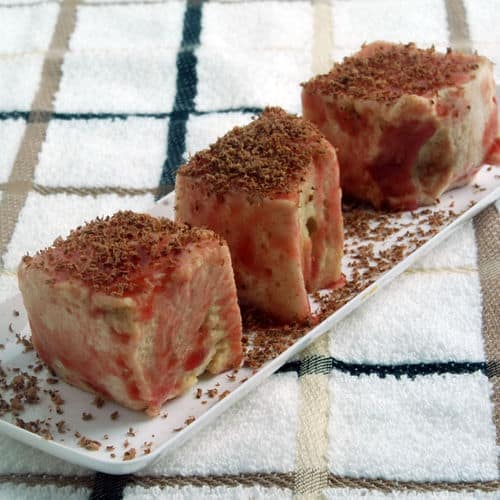 Using a marshmallow base turns a rich, decadent chocolate covered cherry into a lighter equally satisfying treat. I add cocoa powder to the marshmallow mixture, resulting in a light chocolate flavor and cherry juice is turned into a marshmallow coating. These addictive snacks have great flavor and are a visually interesting dish that will get your guests talking!
Using a marshmallow base turns a rich, decadent chocolate covered cherry into a lighter equally satisfying treat. I add cocoa powder to the marshmallow mixture, resulting in a light chocolate flavor and cherry juice is turned into a marshmallow coating. These addictive snacks have great flavor and are a visually interesting dish that will get your guests talking!
Tikka Masala Coated Chicken Recipe
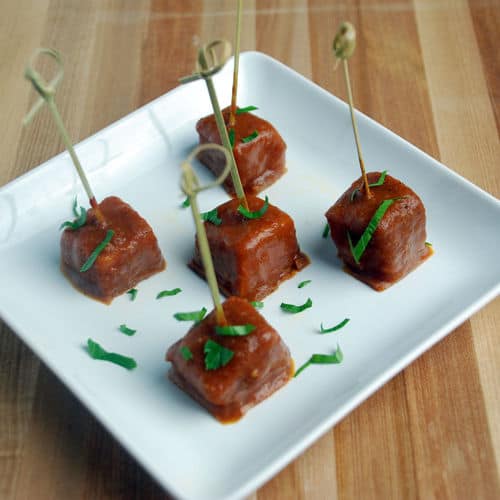 Tikka masala is a traditional English dish at curry houses. With this recipe I reimagined it as a modernist dish by turning the sauce into a gelled coating; it's s a fun play on a old classic!
Tikka masala is a traditional English dish at curry houses. With this recipe I reimagined it as a modernist dish by turning the sauce into a gelled coating; it's s a fun play on a old classic!
Pork with Roasted Apple Pudding Recipe
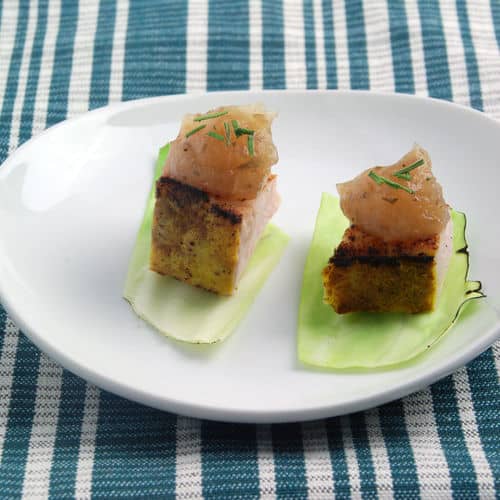 The combination of apples and pork are a classic pairing in Irish cooking. For this recipe, I roast apples and use the modernist ingredient of agar to turn them into a fun pudding topper for pork. By sous vide cooking the pork, you can consistently serve an extra moist and tender meat entree.
The combination of apples and pork are a classic pairing in Irish cooking. For this recipe, I roast apples and use the modernist ingredient of agar to turn them into a fun pudding topper for pork. By sous vide cooking the pork, you can consistently serve an extra moist and tender meat entree.
Blackberry-Peach Wrapped Pork Recipe
 The star of most of my parties is meat and this blackberry-peach wrapped sous vided pork offering is no exception! It makes a fun presentation besides the additional sweetness and flavor from roasting the fruit complements the pork perfectly.
The star of most of my parties is meat and this blackberry-peach wrapped sous vided pork offering is no exception! It makes a fun presentation besides the additional sweetness and flavor from roasting the fruit complements the pork perfectly.
Roasted Poblano, Corn and Bacon Bite Recipe
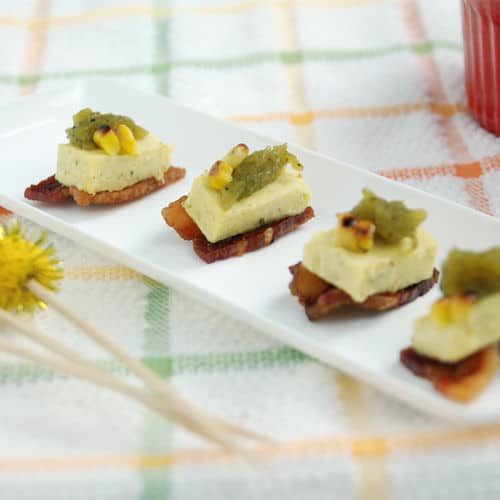 This great party snack use a crispy bacon base topped with a creamy corn custard and a spicy poblano chile fluid gel to make a rich and complex one-bite snack.
This great party snack use a crispy bacon base topped with a creamy corn custard and a spicy poblano chile fluid gel to make a rich and complex one-bite snack.
Habanero-Peach Dip Recipe
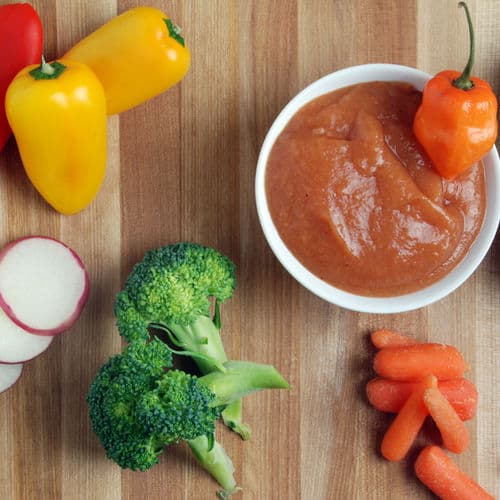 This dip recipe combines the spicy heat of habanero peppers with the sweet taste of fresh ripe peaches. The resulting tangy dip is great on vegetables or even meat. By altering the amount of peppers used, you can raise or lower the heat to suit your guests.
This dip recipe combines the spicy heat of habanero peppers with the sweet taste of fresh ripe peaches. The resulting tangy dip is great on vegetables or even meat. By altering the amount of peppers used, you can raise or lower the heat to suit your guests.
Apple Cider Agar Gel Cubes Recipe
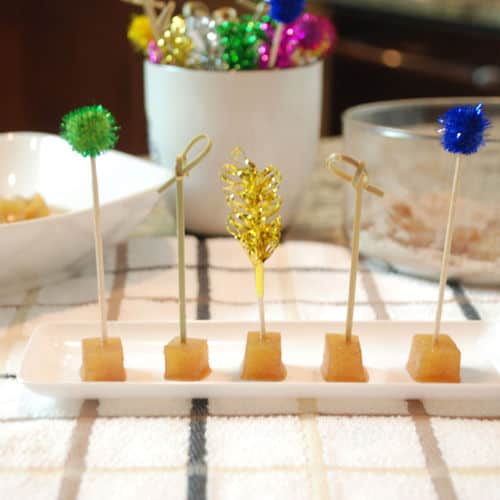 These gel cubes are super easy to put together and they make a great small bite for people to enjoy. The quality of the cider you use will directly relate to how good the gels turn out.
These gel cubes are super easy to put together and they make a great small bite for people to enjoy. The quality of the cider you use will directly relate to how good the gels turn out.
Strawberry Daiquiri Agar Gel Cubes Recipe
 These cocktail cubes are a fun way to entertain your guests. They are rum infused strawberries encased in a daiquiri cube. When you bite into them the cube starts off with a sweet and tart flavor followed up by the kick of the rum-infused strawberries.
These cocktail cubes are a fun way to entertain your guests. They are rum infused strawberries encased in a daiquiri cube. When you bite into them the cube starts off with a sweet and tart flavor followed up by the kick of the rum-infused strawberries.
Shortcakes with Agar Fruit Gels and Siphon Whipped Cream
 One of my favorite spring dishes is shortcakes with fresh fruits or berries. The other day I decided to take advantage of some great looking berries and made a variety of shortcakes. To make them more modern, and to work on some recipes for my upcoming book, I used some whipping siphon foams and agar agar fruit gels.
One of my favorite spring dishes is shortcakes with fresh fruits or berries. The other day I decided to take advantage of some great looking berries and made a variety of shortcakes. To make them more modern, and to work on some recipes for my upcoming book, I used some whipping siphon foams and agar agar fruit gels.
Salmon Bites with Tomatillo Agar Fluid Gel Sauce Recipe
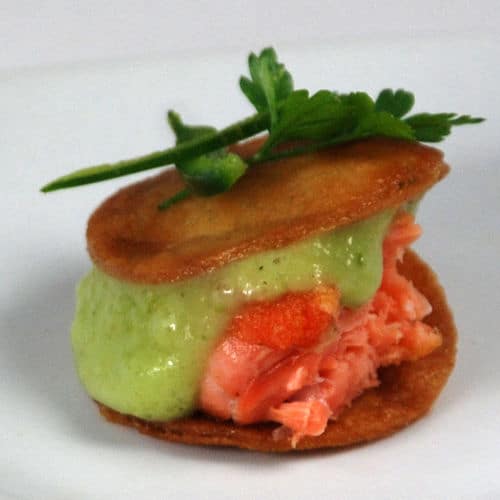 These Mexican inspired salmon bites pack a lot of flavor in a little package. The acidity from the tomatillos compliments the salmon perfectly and the crunch from the fried tortillas adds great texture.
These Mexican inspired salmon bites pack a lot of flavor in a little package. The acidity from the tomatillos compliments the salmon perfectly and the crunch from the fried tortillas adds great texture.
Orange-Ginger Gel Sheets
 One interesting use of modernist gelling is to create pliable gel sheets. These gel sheets are made by adding a combination of agar agar and gelatin to a flavored liquid and letting it set. The agar and gelatin add both elasticity for strength and a nice brittleness for flavor release. The ratio of the two ingredient will determine the final characteristic of the gel sheets.
One interesting use of modernist gelling is to create pliable gel sheets. These gel sheets are made by adding a combination of agar agar and gelatin to a flavored liquid and letting it set. The agar and gelatin add both elasticity for strength and a nice brittleness for flavor release. The ratio of the two ingredient will determine the final characteristic of the gel sheets.
Bloody Mary "Ants on a Log" Recipe
 My wife's relatives in Florida love their Bloody Marys and this is her modernist take on them, focusing on the celery garnish and turning it into the serving vessel a la the traditional "ants on a log" children's snack.
My wife's relatives in Florida love their Bloody Marys and this is her modernist take on them, focusing on the celery garnish and turning it into the serving vessel a la the traditional "ants on a log" children's snack.
Agar Bloody Mary Gel Recipe
 One of the fun things about modernist cooking is changing the textures of common dishes while keeping the flavors the same. This creates almost a confusion in the palate when it's being eaten and the brain recognizes the flavors but not the textures. This recipe creates a solid Bloody Mary gel with agar agar that has applications in various dishes.
One of the fun things about modernist cooking is changing the textures of common dishes while keeping the flavors the same. This creates almost a confusion in the palate when it's being eaten and the brain recognizes the flavors but not the textures. This recipe creates a solid Bloody Mary gel with agar agar that has applications in various dishes.
Papaya Agar Agar Gel Cube Recipe
 These agar gel cubes are a great way to add a unique visual style to a dish, as well as creating little bursts of papaya. You could use a similar agar recipe to gel many different liquids, depending on the dish you are creating.
These agar gel cubes are a great way to add a unique visual style to a dish, as well as creating little bursts of papaya. You could use a similar agar recipe to gel many different liquids, depending on the dish you are creating.
Papaya Agar Agar Noodles Recipe
 Gels are a very common technique in modernist cooking. This modernist recipe uses the gelling properties of agar agar to make papaya noodles. These agar agar noodles are a great addition to a several different dishes and are an easy way to add a touch of flair.
Gels are a very common technique in modernist cooking. This modernist recipe uses the gelling properties of agar agar to make papaya noodles. These agar agar noodles are a great addition to a several different dishes and are an easy way to add a touch of flair.
Simple Balsamic Vinegar Pearls Recipe and How to Guide
 One of the easiest molecular gastronomy recipes to try is by creating "pearls". Most pearls are solid jelly balls that can be used to garnish dishes or as an amuse-bouche. Here we use sweet-sour balsamic vinegar to make pearls that are a great way to add a hit of flavor to many different dishes. The process of making them is even pretty easy.
One of the easiest molecular gastronomy recipes to try is by creating "pearls". Most pearls are solid jelly balls that can be used to garnish dishes or as an amuse-bouche. Here we use sweet-sour balsamic vinegar to make pearls that are a great way to add a hit of flavor to many different dishes. The process of making them is even pretty easy.
 This article is by me, Jason Logsdon. I'm an adventurous home cook and professional blogger who loves to try new things, especially when it comes to cooking. I've explored everything from sous vide and whipping siphons to pressure cookers and blow torches; created foams, gels and spheres; made barrel aged cocktails and brewed beer. I have also written 10 cookbooks on modernist cooking and sous vide and I run the AmazingFoodMadeEasy.com website.
This article is by me, Jason Logsdon. I'm an adventurous home cook and professional blogger who loves to try new things, especially when it comes to cooking. I've explored everything from sous vide and whipping siphons to pressure cookers and blow torches; created foams, gels and spheres; made barrel aged cocktails and brewed beer. I have also written 10 cookbooks on modernist cooking and sous vide and I run the AmazingFoodMadeEasy.com website.
Affiliate Disclaimer: Some links on this site might be affiliate links that if used to purchased products I might receive money. I like money but I will not endorse something I don't believe in. Please feel free to directly go to any products I link to and bypass the referral link if you feel uncomfortable with me receiving funds.
































